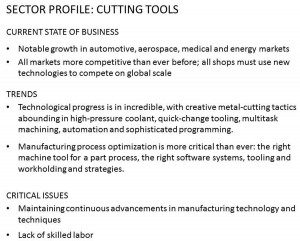2012 State of the Industry: Cutting Tools
Forecast: Creative metal-cutting tactics abound as shops focus on optimizing their manufacturing processes to tackle notable growth in the automotive and aerospace sectors.
Posted: January 13, 2012
Forecast: Creative metal-cutting tactics abound as shops focus on optimizing their manufacturing processes to tackle notable growth in the automotive and aerospace sectors.
 Kurt Nordlund
Kurt Nordlund
President, Seco Tools Inc.
Manufacturer of metal cutting solutions for milling, turning, holemaking, holding systems and other metalworking applications.
CURRENT STATE OF BUSINESS
While there has been a lot of different dynamics happening in the financial market, in general, we are expecting continued strong growth in manufacturing through 2012 and beyond. Manufacturing continues to be unaffected by disparaging news from the financial side, mainly because manufacturing is what has been driving the economic recovery.
Growth will continue in 2012, but it will be paired with some moderation. However, we don’t foresee any negative numbers as far as manufacturing growth is concerned. We also predict China will grow even faster than it has been and that demand from Europe will also help drive further growth in manufacturing.
We are currently involved in many customer programs and projects that will run well into 2012 and quite possibly into the following years. This is why we are especially optimistic about the outlook for manufacturing.
Market sectors we foresee notable growth include automotive and aerospace. For automotive, factors such as average age of cars currently on the road, large numbers of new drivers and the upsurge in alternative powered vehicles will be the catalysts for growth in 2012. And for aerospace, new recently launched programs such as the 787 Dreamliner, along with a huge backlog of existing orders of other types of aircraft, will provide manufacturing momentum through this year.
MAJOR TRENDS
Complete manufacturing process optimization, in my opinion, will become more and more critical to manufacturing. Shops will not only focus on having the right machine tool for a part process, but also on having the right software systems, tooling and workholding, along with having the right strategies in place.
The key goal of process optimization is getting the most out of an investment, and today’s shops are continuously re-evaluating and scrutinizing every aspect of every part-processing operation. These shops are more open minded and more accepting of changes and of exploring different possibilities, and an increasing number of shops will be following suit in 2012.
Nothing is taken for granted anymore, and this has been especially true for cutting tools and automation, which in the past had tended to be treated as afterthoughts. Additionally, computers have had a huge impact, giving shops 360-deg overall views of their processes to quickly evaluate and easily determine how and where to optimize.
The dynamics of how our relationships/interactions with customers have changed as a result of continuous process optimization – both theirs and ours. We now work with our customers on a partnership basis, as opposed to the typical customer-supplier relationship. Our customers expect us and other suppliers to provide technical advice, training and support and to work closely with them to develop total manufacturing solutions that will optimize overall part processing.
At Seco, we maintain a complete understanding of our customers’ processes/operations and conduct ourselves as manufacturing consultants where we offer more than just a product.
CRITICAL ISSUES
One critical issue/challenge will be maintaining continuous advancements in manufacturing technology and techniques. We in the manufacturing industry mustn’t rest on our laurels just because business is good. We must keep driving continuous improvement.
Shops must maintain competitiveness and differentiate themselves from the competition. Shops have to offer more than the guy next door. This can be achieved through specialization and truly understanding customers and fulfilling their specific manufacturing needs, yet also having the versatility to diversify and serve several different market segments simultaneously.
PERSONAL INSIGHTS
Continuous improvement must be a company-wide mindset and one that is strongly encouraged and supported with training. A true drive to improve needs to be created, which in turn, will generate increased levels of enthusiasm among those individuals involved.
Today’s shops have to avoid being so rigid that they stifle innovation with a “this is the way we’ve always done it” mindset. Most people, given the chance, are innovative and will find ways to improve upon a process. However, that innovative way of thinking requires constant encouragement.
Seco Tools, Inc., 2805 Bellingham Drive, Troy, MI 48083, 248-528-5200, Fax: 248-528-5600, [email protected], www.secotools.com.
 John Israelsson
John Israelsson
President, Sandvik Coromant U.S.
A leading manufacturer of cutting tools for the metalworking industry, with more than 25,000 products developed by specialists in 60 countries across the globe.
CURRENT STATE OF BUSINESS
Despite the hard-hitting recession—from which the manufacturing industry is slowly recovering—foundational strengths have existed all along. Inclinations toward technological innovation, education and scientific discovery have been, and continue to be, the fundamental drivers of U.S. manufacturing. Even during one of the worst economic climates in recent memory, we saw more than a few examples of shop owners who continued to invest, progress and excel.
What’s more, we’ve seen strong efforts across the industry to re-shore manufacturing operations. Rising overseas production and transportation costs, a better understanding of the overall supply chain, and strong activity in the U.S. market have encouraged this movement. U.S.-based companies large and small are discovering that, with the right technology, they’re able to remain even more competitive and profitable at home, rather than abroad.
According to the American Machine Tool Distributors’ Association (Rockville, MD), manufacturing technology orders were up 91.9 percent in 2011. Nevertheless, it’s crucial that we remain open-minded to new ideas, and dare to challenge the status quo. While economic uncertainty remains, I believe the future looks bright. If we as an industry continue to put emphasis on R&D, workforce development and ongoing education, the global manufacturing landscape is ours for the taking.
That being said, the playing field has never been more competitive, and the surge in growth we’ve seen in the last several months may be slowing. Every U.S. shop now competes on a global scale—whether we like it or not. To succeed, shops must machine parts faster and more cost efficiently. What’s more, the fastest-growing and most lucrative industries require a solid investment in top-of-the-line technology, tooling and employee education—and an eye toward innovative machining processes and business operations.
This is especially true for companies that are moving manufacturing operations back to the United States. These organizations must take a creative approach toward technology to maintain cost-effective operations domestically.
MAJOR TRENDS
While some areas, such as defense, are slowing, we’re continuing to see growth in the aerospace, medical and energy industries. And the technological progress in these areas is incredible. Our new patent-pending gear-milling methods, for example, offer a huge opportunity. Large gears, such as those required for energy applications, have typically been extremely time-consuming to machine—and require costly and specialized equipment. With our new method, programming and multi-axis machine capabilities determine the geometry of the gear, significantly cutting cycle times and tooling costs.
Examples of creative metal-cutting tactics such as this abound—for every industry and application. Increasingly effective technologies including high-pressure coolant, quick-change tooling, multitask machining, automation and sophisticated programming are also contributing to the success of shops large and small.
In 2012, manufacturers need to focus on getting in on these technologies at the ground floor—and the only way to do that is to have close partnerships with the companies that pioneer them. Machine-tool makers, tooling partners, and software and accessory providers are no longer just suppliers. We’re strategic partners, with a deep pool of resources that shops can and should rely on.
Many companies have already begun to embrace this idea—as evidenced by the enthusiasm at the education- and strategy-focused imX show in Las Vegas last fall. In the coming year, we believe this ideology will continue to gain credence. We’ve seen an uptick in interest in our consultative support—which includes machine investment planning, productivity improvement, tooling consolidation programs, operational analysis and more. Participation in our educational efforts, including our Smart Event series, is also on the rise.
This tells us that shop owners are committed to optimizing their processes and technologies in 2012, in spite of—or perhaps because of—ongoing economic uncertainty. Thanks to this interest in improvement and education, I expect the trend toward new technology adoption to continue. In our experience, once shop owners acquire enhanced tooling packages and advanced machine tools and accessories, they’re hooked—and continue to invest heavily to maintain their competitive edge.
In addition to the physical technologies, we see an industry that is focused on using creative approaches to solve problems. In other words, the machine and the tooling is only half the battle; shops are working with partners and companies that can think outside of the box to implement unconventional processes and programming methods that take productivity to the next level. This is happening at Sandvik Coromant and other industry-leading companies.
Our approach is to provide total solutions, working closely with customers and machine-tool manufacturers on application-focused machining optimization. By maintaining and expanding the expertise of our staff, we can further this focus in our application and productivity centers, and within our field-based support network.
CRITICAL ISSUES
In the coming year, the industry will continue to face a lack of skilled labor, making educational efforts evermore important. Early involvement—at a high-school and college level—is important, but so is ongoing career development. Many shops are hiring inexperienced employees and putting them through thorough training programs to get them up to speed.
This has increased the demand for training and application support from tooling and machine partners, and it’s our responsibility to offer a solid education on our products as well as general best-practice teachings. Automated machining technologies are also taking some of the pressure off—helping shops optimize and streamline their employees’ duties and focus.
PERSONAL INSIGHTS
While global economic instability remains, the opportunities for domestic manufacturing are exciting and abundant. If shops continue to work with industry-leading partners early and often, they’ll have the resources they need to stay on top in 2012 and beyond.
Sandvik Coromant U.S., 1702 Nevins Road, PO Box 428, Fair Lawn, NJ 07410-0428, 201-794-5000, Fax: 201-794-5257, [email protected], www.sandvik.coromant.com/us.















